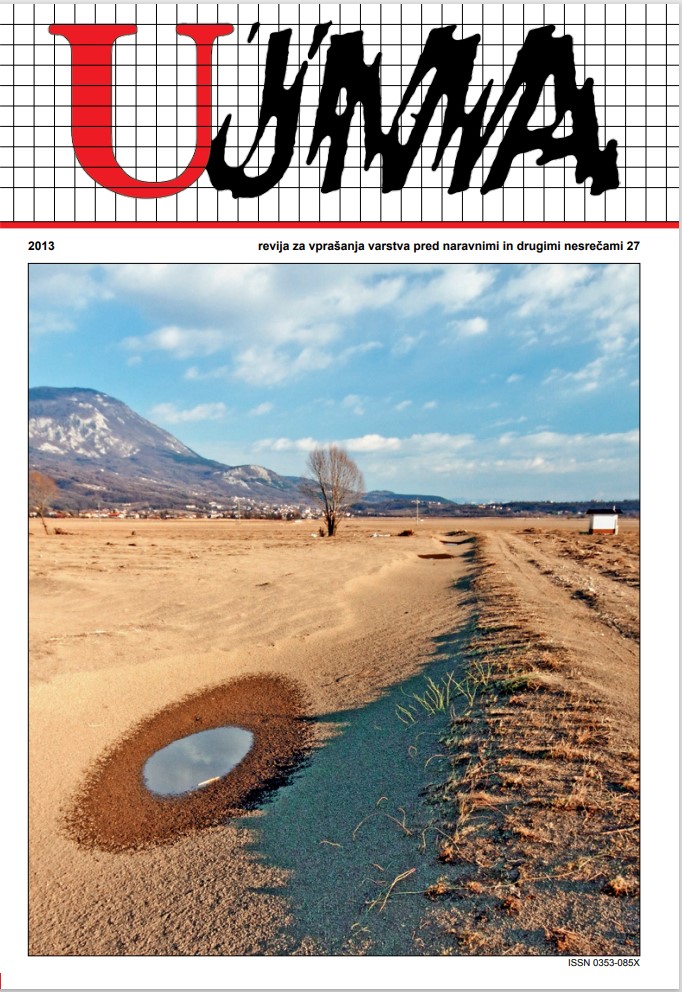EVACUATION IN THE EVENT OF A DISASTER IN THE KRŠKO NUCLEAR POWER PLANT
Abstract
This article examines the theoretical and empirical findings, and deals with the behaviour of people during evacuation. The authors first define and classify evacuation, and introduce three psychosocial theories related to evacuation. Furthermore, they discuss the theory of stampede, allegiance, normative approach and social identity. The second part of the article focuses on the results of a public opinion poll and an interview on the readiness of the population, institutions and companies for evacuation in the event of a disaster in the Krško Nuclear Power Plant, which has been conducted in October 2012. The public opinion poll involved 502 inhabitants of the settlements located in a three-kilometre zone around the nuclear power plant. The interview included twelve management members of major companies and intuitions, operating in the area of the Krško municipality. The results of the public opinion poll and interview confirm some basic theoretical assumptions regarding the behaviour of people during evacuation. At the same time, they draw attention to some major deficiency in the preparation for the evacuation.
References
Bolin, R., 1989. Natural Disasters. V: R. Gist & B. Lubin (Eds.). Psychosocial Aspects of Disaster. New York: Wiley.
Dash, N., Gladwin, H., 2005. Evacuation decision making and behavioral responses: individual and household. Natural Hazards Review, 8: 69–77.
Drabek, T. E., 1986. Human System Responses to Disaster. New York, Springer-Verlag Fischoff, B., Li chtenstein, S., Slovic, P., Derby, S. L., Keeney, R. L., 1981. Acceptable risk. Cambridge, Cambridge University Press.
Girod, J., 2012. The psycho-social theories in emergency evacuation agent-based simulation. IRL Report, Grenoble, Ensimag, May 18.
Lindell, M. K., Perry, R. W., 1991. Understanding Evacuation Behavior: An editorial Introduction. International Journal of Mass Emergencies and Disasters, 9, 2: 133–136.
Malešič, M. (ur.), 2004. Krizno upravljanje in vodenje v Sloveniji: izzivi in priložnosti. Ljubljana, Fakulteta za družbene vede.
Malešič, M., Polič, M., Bašić Hrvatin, S., 2006. Komuniciranje v krizi. Ljubljana, Fakulteta za družbene vede.
Malešič, M., Polič, M., Juvan, J., 2013. Psihološke in socialne značilnosti evakuacije. Ljubljana, Fakulteta za družbene vede.
Malešič, M., Polič, M., Uhan, S., Prezelj, I., Juvan, J., Bajec, B. 2013. Spoznavni in zaznavni vidiki evakuacije ob jedrski nesreči. Ljubljana, Fakulteta za družbene vede.
Mas, E., Imamura, F., Koshimura, S., 2011. Modeling the decision of evacuation from tsunami, based on human risk perception. Disaster Control Research Center, Tohoku University, Japan.
Murray-Tuite, P., Schweizer, L., Liu, S., 2009. Impacts of Family Responsibility and car Availability on Household No-Notice Evacuation Time. Urban Ethics and Theory.
Perry, R. W., 1979. Evacuation Decision-Making in Natural Disasters. Mass Emergencies, 4: 25–38.
Perry, R. W., Lindell, M. K., 1997. Principles for Managing Community Relocation as a Hazard Mitigation Measure. Journal of Contingencies and Crisis Management, 5, 1: 49–59.
Sandman, P. M., Lanard J., 2005. Acknowledging Uncertainty. Dostopno prek: http://www.psandman. com/terror.htm.
Quarantelli, E. L., 1984. Perceptions and Reactions to Emergency Warnings of Sudden Hazards. Ekistics, 309: 511–515. 16. Quarantelli, E. L., 2001. The Sociology of Panic. University of Delaware, Disaster Research Center, Preliminary Paper #283.
Sarangi, S., Krief, J., 2011. An integrated approach to modeling evacuation behavior: Hyperbolic discounting and peer effect. Gulf Coast Research Center for Evacuation and Transportation Resiliency.
Slovic, P., 1986. Informing and educating the public about risk. Risk Analysis, 6: 403–415.
Turner, R. H., Killian, L. M., 1972. Collective Behavior, Englewood Cliffs, Prentice Hall.
Wenger, D. E., 1978. Community Response to Disaster, V: Quarantelli E. L. (Ed.), Disasters, London, Sage.
Wojciechowska, K., 2010. Extension of the probabalistic evacuation decision model. HKV, The Netherlands.
Downloads
Published
Issue
Section
License

This work is licensed under a Creative Commons Attribution-NonCommercial-NoDerivatives 4.0 International License.
The articles are made available to the public under Creative Commons Attribution-NonCommercial-NoDerivatives 4.0 International (CC BY-NC-ND 4.0).


